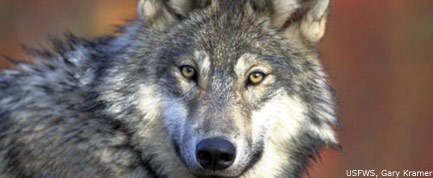
Some animals forget to fear longstanding predators if these enemies do not hunt them constantly, a new study finds.
In particular, moose, caribou, bison and elk fear predators only if they encounter them regularly, according to a study by Joel Berger of the Wildlife Conservation Society (WCS) in New York.
However, Berger also found that the prey animals could "relearn" their fears very quickly, which should be good news for programs attempting to reintroduce predator species into their natural habitats. It means prey populations might plummet intially when a predator appears again after a lengthy absence, but they will reach equilibrium again shortly after.
Berger's findings are detailed in the latest issue of the journal Conservation Biology.
Short memory
The 10-year study took Berger all around the world. He traveled to polar islands of Greenland, the Arctic archipelago of Svalbard, and Norway, where wolves, tigers and brown bears—the natural predators of the ungulates studied—no longer exist. He went also to Yellowstone and Grand Teton National Parks, where these same predators have been re-established after periods of absence.
In each location, Berger played recordings of howling by wolves and heavy breathing by tigers and recorded the reactions of the prey. For controls, Berger did the same thing for prey animals living in Eastern Siberia, Boreal Canada and Alaska, where the predators are still found.
Sign up for the Live Science daily newsletter now
Get the world’s most fascinating discoveries delivered straight to your inbox.
Animals living in locations where the predators no longer existed exhibited lower levels of vigilance, clustering behavior and flight responses than their counterparts living under constant threat of being hunted.
Elk in the mountains of Siberia, for example, which coexist with tigers, wolves and bears, responded five times faster to the recordings than did elk in Colorado’s Rocky Mountain National Park, where elks' top predators have been absent for about 90 years.
The prey animals were also exposed to recordings of calls made by howler monkeys, whose vocalizations vary in frequency and therefore sound like howling wolves. The prey animals, even those actively hunted by wolves, largely ignored the monkey calls, indicating they were capable of distinguishing between sounds made by known threats and other sources.
Berger’s study also found that prey animals can relearn their fear in a single generation. Reactions by bison to the predator calls in Yellowstone National Park—where grey wolves were reintroduced in 1995 after a nearly 70-year absence—even exceeded those of bison in Boreal Canada, where wolves are still naturally found.
Conservation implications
Berger expects his findings will come as welcome news for those trying to reintroduce predator species back into their natural environments after years of absence. “It’s good news [for] northern temperate and arctic fauna that they figure it out pretty fast,” Berger told LiveScience. “Because initially they may get hit hard, but they will learn.”
Berger recalls that when grey wolves were reintroduced into Yellowstone, “some people said ‘Ten years from now, we will not have elk.’ Well, there’s still a lot of elk there. The same is true for Wyoming.”
Ecosystems where the top predators are wiped out can suffer from overgrazing by prey species, which are no longer kept in check. But “if prey species become afraid, they tend to move around more and not concentrate on vegetation in certain areas,” Berger said in a telephone interview. “There’s a release, the vegetation is given a reprieve, and all the species that rely on vegetation, like migratory birds, do better when these large carnivores are back in the system.”
But allowing predator species to repatriate their natural environments is not enough, Berger said. They must also be allowed to breed, so their populations grow large enough that their presence is felt once again.
This is one of the major problems programs trying to re-establish natural predator species currently face. Berger’s findings come at a time when, after more than $23 million was spent to re-introduce wolves in the northern Rocky Mountains, the animals' federal protection is set to expire. The states of Wyoming and Idaho have already proposed plans that would allow for as much as 85 percent of these once-protected wolves to be killed, according to the WCS.
“There’s a density effect,” Berger said. “If you have just a few wolves that are put into a system, they’re still far below what the number should be when the system is balanced. They’re unlikely to create this effect where the species are moving about.”









